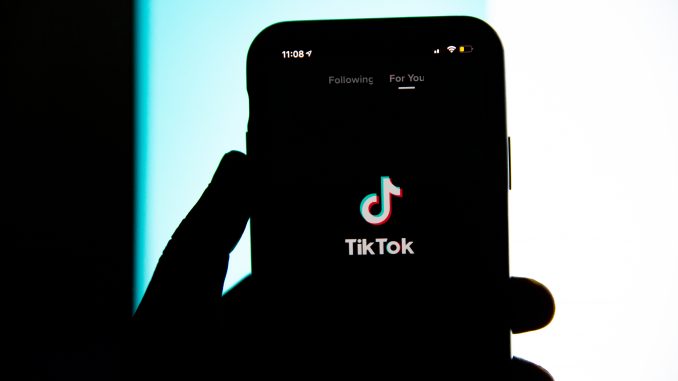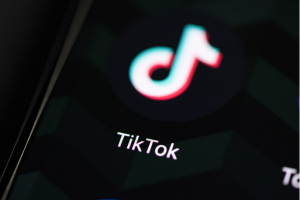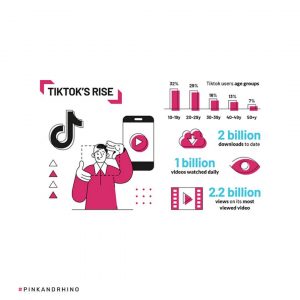
“Make every second count”, “Make your day”…
With the rapid development of web2.0, digital social media platforms have become the infrastructure in people’s lives, which means that digital applications significantly impact culture, economy, and politics. In particular, TikTok has gone global in just four years, overtaking Facebook as the world’s most downloaded app for Android and iOS in 2021 (Katie, 2021). “Make every second count,” “Make your day” are the slogans of TikTok, which is highly relevant to the current generation living in the digital age to meet entertainment needs and information sharing.

Figure 1: “TikTok app icon” by Ivan Radic is licensed under CC BY 2.0
What is TikTok?
TikTok was launched in 2016 by one of the most valuable Chinese Technology companies, which is called ByteDance (Deborah, 2021). Since then, TikTok has gradually become one of the most popular social media applications in the world. Users can use their smartphones to watch and share short videos of only 15 seconds on the platform(Deborah, 2021), which is undoubtedly suitable for all ages in fast-paced life nowadays. Users can open the app to watch short videos anytime and anywhere, dramatically increasing the needs of people for entertainment and information. In addition, the difference between TikTok and other applications is that it allows users to create video content with personal characteristics. Because the app has addictive short videos, background music, filters and stickers (Lydia, 2021), users can also add topics they are interested in, which improves the participation of users to a certain degree.
TikTok Promo. Viemo. (2021). Retrieved from https://vimeo.com/513368509.
The Story of Tiktok
When the payment giant Alibaba and the social giant Tencent almost divided the Chinese Internet market in 2016, ByteDance developed a social media platform like TikTok, which is also called Douyin in China (Deborah, 2021). TikTok redefines the Internet, reshapes the flow of information, short videos, and other new content formats that instantly become the first in the Chinese media industry. In addition, in the emerging short video industry in China at that time, there was already a strong competitor called KuaiShou. However, with attractive short music videos, powerful algorithmic advantages, and an immersive experience for users, Douyin just used one year to surpass KuaiShou and won the domestic market (Christina, 2020).
Meanwhile, TikTok was attacked by the Internet giant Facebook and musical.ly, the originator of short music videos. Because TikTok wanted to enter the overseas market in 2017. Musical.ly was established earlier than TikTok, and it has won foreign markets as a cultural content product. Therefore, TikTok chose to spend 1 billion dollars to acquire musical.ly, which has already had overseas operating experiences (Christina, 2020). It turns out that TikTok made the correct decision because the value of ByteDance was worth up to 140 billion dollars in 2020 (Deborah, 2021), which will make it the most valuable startup company in the world.
The Successful Marketing Strategy
TikTok uses “international products and localized content” strategies to overcome cultural differences in overseas markets. At the same time, the commonality between domestic and overseas is to attract a large number of users through the promotion of local celebrities. TikTok has about 689 million users in more than 200 countries worldwide until January 2021, and the average time each user uses the app is up to 13.3 hours per month (Katie, 2021). The increase in users has attracted a large number of advertisers, and TikTok began running display advertising in 2019 (Deborah, 2021). Instead, brands create and publish short videos on TikTok like the other users, and they also pay to promote their activities to famous users with a fan base.
Although TikTok is in its infancy in marketing, more and more agents hope to help brands create accounts on TikTok to gain attention. TikTok is a platform different from traditional social media, which means conventional advertisements that emphasize the superior quality of products are not attractive to users (Deborah, 2021). Therefore, relaxing and exciting activities based on background music can be imitated by users and become famous on the platform. For example, e.l.f. Cosmetics collaborated with some social media influencers to create an online contest called #eyeslipsface, which became the most influential event in TikTok history. The activity attracted 5 million users to participate in the video production, and the total number of views has reached 7 billion on the Internet (Liz, 2020). The activity brought huge profits to the brand to a certain extent and also increased the popularity of the platform.
How Does TikTok Make Money?
Like other social media platforms such as YouTube and Instagram, TikTok also cooperates with brands and provides them with paid advertising and product promotion services (Lydia, 2021). Through information flow videos, acquisitions, label challenges activities, and brand effects, brands can enhance their marketing strategies. For instance, the advertisement can be a short video that appears when users scroll through the page, or the ad will pop up immediately when users open the application (Lydia, 2021).
The live e-commerce model on TikTok has become very popular in China. When users enter the online room, the sellers will attract users to purchase the goods by using discounts and concessions in the live broadcast on the platform. Thus, the common interests of platforms and merchants are closely related to consumers. Besides, TikTok has developed coins as an in-app currency that users over 18 can purchase and use the coin to buy virtual gifts for other users they are interested in. The report shows that the users of TikTok spending more than 110 million dollars in just a few months (Lydia, 2021). With the involvement of capital and the continuous development of the platform, TikTok may become the most valuable application in the world.
“TikTok” and “Techlash”
The monopoly and oligopoly trend of the Internet industries has become a concern for the government and the public (Terry et al., 2019). The society is moving from an open Internet to an era of information monopoly which means strengthening supervision of digital platform companies has become a general requirement. When TikTok enters overseas markets, in addition to content localization, there is a more critical factor that is the control of the platform by overseas countries.
Like most social media applications, TikTok cannot be avoided.

Figure 2: “TikTok users statistics” by Pink Rhino is licensed under CC BY 2.0
The data shows that 32% of TikTok users are teenagers between the ages of 10 and 19 (Figure 2). Soon after, the Federal Trade Commission sued TikTok for illegally collecting children’s information in 2019. TikTok platform company paid 5.7 million dollars in the United States to resolve its allegations (Deborah, 2021). Since then, the United States and India have banned TikTok and many other Chinese-made apps in 2020. The reason is that the Chinese Communist Party may use collected user data to monitor American citizens, thereby posing a threat to national sovereignty.
However, it is hard to determine the definition of a media company in the digital environment nowadays (Terry et al., 2019), which shows the difficulty for governments and regulators to rein in digital media companies with the same regulatory policies as traditional media companies.
Conclusion
As a digital media platform that stands out, TikTok changes the lifestyle of users and affects the global economy, politics, and culture. In the era of the rise of digital media, TikTok still depends on self-regulate and requires government policies to avoid social and user concerns when it faces global markets.
References
Christina G. (2020, July 19). The Origins of TikTok. Medium. https://christinagayton.medium.com/the-origins-of-tiktok-5efa7da4b3e6
Deborah D. (2021, July 22). What Is TikTok? Investopedia. https://www.investopedia.com/what-is-tiktok-4588933
Flew, T., Martin, F., & Suzor, N. (2019). Interent regulation as media policy: Rethinking the question of digital communication platform goverence. Journal of Digital Media & Policy, 10(1), 33-50.
Katie S. (2021, May 5). 23 Important TikTok Stats Marketers Need to Know in 2021. Hootsuite. https://blog.hootsuite.com/tiktok-stats/#:~:text=TikTok%20has%20a%20reputation%20for,of%20the%20app’s%20user%20base.
Liz F. (2020, December 10). Following TikTok success, E.l.f. Cosmetics expands to Triller. Glossy. https://www.glossy.co/beauty/following-tiktok-success-e-l-f-cosmetics-expands-to-triller/
Lydia K. (2021, April 23). How Does TikTok Make Money? GoBankingRates. https://www.gobankingrates.com/money/business/how-does-tiktok-make-money/
Motion Media Group. (2021, February 17). TikTok Promo [Video]. Vimeo. https://vimeo.com/513368509

This work is licensed under a Creative Commons Attribution 4.0 International License.